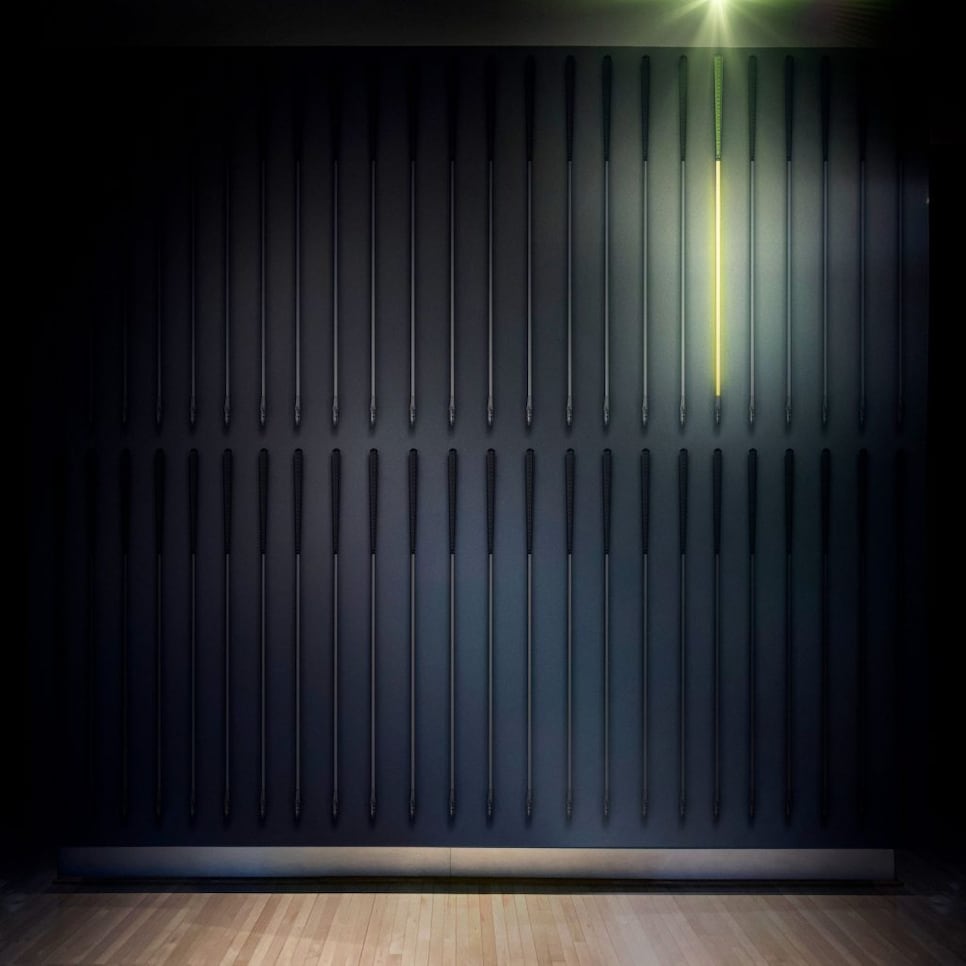From the Magazine
The search for the best shaft: How to navigate one of golf's most complex equipment equations

The field at this year’s Puerto Rico Open had 132 exceptionally talented golfers with similarly perfect swings as hypnotic as the nearby palm trees blowing in the island breeze. But when you looked closer, a subtle but distinct difference kept reflecting in the light: bits of metallic blue in one moment, sparkly green or smoky black in another place, shiny silver here, and hints of red, yellow or even orange over there, each tracing that perfect line between hands and clubhead. Shoes, hats and even physiques have a certain consistency on the PGA Tour, but the driver shaft reveals a rainbow palette of variety, and not just in colors—68 of the 132 players used a different driver shaft. On its face, that number sounds absurd. Tour-player swings all hover in the same swing-speed range. Why would there need to be so many models? How is such subtlety possible or necessary?
The reasons aren’t entirely clear, but finding a shaft that’s perfectly suited for your game isn’t only for golfers with their names on their bags. A Golf Digest/Club Champion test with a 10-handicapper revealed as much as a 17-yard difference between similar—but not the same—driver shafts. And even that gain isn’t as clearly defined as it might initially appear to be. In a game increasingly adept at measuring potential performance, the mysterious, mystical shaft is the game’s last great frontier. But like all frontiers, it still lacks a map.
The voyage for a pro starts with a precise fitting, says Don Brown, vice president of innovation and product creation for True Temper Sports, makers of the Project X brand of shafts, which includes the HZRDUS and Even-Flow lines. “Guys can use a launch monitor to dial in tenths of a degree of launch and spin by 50 revolutions per minute to get optimal launch conditions,” Brown says, “whereas 20 years ago, they mostly stood on the range with their caddies and said, ‘Yeah, that looks like the right window.’ ”
But when the same analytical tools that PGA Tour players rely on are found at nearly any golf shop, the shaft search becomes a shifting minefield of science joining forces with art. The game’s best clubfitters watch the readouts from high-tech launch monitors with nuclear physics-like precision while trying to translate all that math into what the 12-handicapper in front of them is trying to communicate about “feel.”
One who has studied that variety is Jon Sinclair, one of the top-rated teachers in Texas and a clubfitter and consultant to shaft manufacturer TPT. Sinclair has captured 3-D data on thousands of swings, perhaps more than anyone, and he has seen just three or four things that rise to the level of similar fundamentals in all those moves. “When I look at all the 3-D swings in my database, it is enough to tell you that a golf swing is a fingerprint,” he says. “Having all these shaft options shouldn’t be a surprise; it should be encouraging.”
The implication of these swing varieties and shaft options is clear: The vast majority of recreational golfers are playing the wrong driver shaft.
Whether they have the capacity to realize this and the time, interest and money to discover the truth is a more difficult question. Nick Sherburne, founder of leading clubfitting-franchise Club Champion, believes 90 percent of average golfers use a shaft that is not optimal for their potential.
“They just have a run-of-the-mill golf shaft,” he says, admitting, of course, that part of his business is getting golfers into the right and often more expensive shaft. “It’s not that what they have is crap; it’s that it’s not specific. The shaft is the missing link to the best possible performance. Get the right shaft and your swing becomes more effortless. Let the head solve direction. The right shaft is going to be all about consistency and speed, speed, and more speed.”
The challenge is that there are thousands of potential right shafts. Companies like Fujikura, Mitsubishi and True Temper each offer hundreds of driver shaft options, sometimes dozens under the same model. Fujikura’s Ventus, which has been the most played shaft on the PGA Tour, is available in 23 versions on its website. True Temper’s Project X HZRDUS has 70 varieties. Mitsubishi’s tour-proven Tensei family of driver shafts has 111 options.
Each of those companies, and more than a dozen others of substance, are cooking up more each day. Although there is considerable overlap among models, weights and flex profiles, the differences remain hidden in pockets of knowledge among fitters and engineers. Mix in driver heads that adjust and the fact that individual shafts can be cut from the tip end to alter stiffness, and it seems paralyzing for the lonely golf consumer to even start on the journey to finding the right one.


The clubhead speeds of Collin Morikawa (top) and Viktor Hovland (above) are nearly the same, but their different movements during the swing lead them to use different shaft models. Factors include how aggressively the player transitions in a few milliseconds of the downswing and how firm or soft various sections of the shaft feel.
To their credit, shaft companies and a fair number of club manufacturers offer interactive online tools and guides that allow golfers to match swing characteristics and trajectory desires to narrow that universe of shafts. GolfShaftReviews.info, the website that is to golf-shaft gearheads what the Sibley Guide to Birds is to aspiring ornithologists, has profiled the technical details of more than 2,000 driver shafts. TrueFitClubs.com measures shafts across 21 metrics to match your golfer profile to get specific online recommendations. Mizuno’s Shaft Optimizer, first developed for iron shafts and now used for drivers, has sophisticated strain gauges, hardware and software to demonstrate how your swing makes a shaft bend. Then Mizuno correlates those forces to shaft profiles that will fit your game best. Even artificial intelligence has come to shaft matching. SwingFit, with locations in South Carolina and Florida, uses motion-capture analysis to track more than 30,000 data points per swing to determine the ideal club and shaft combination.
But no matter how detailed the analysis, the right shaft usually comes down to the hitting—and all the quirks that implies. Feel to a golfer, even an average Joe, can’t be reduced to an eHarmony.com algorithm. (Relationships between humans involve compromise; the right shaft matched to the right golfer, on the other hand, is the perfect bliss of the gods.)
“When you’ve got a flexible stick in your hands and what is basically a hammerhead, and then you have 20 million individuals delivering this hammerhead in 20 million different ways, well, that’s a mystery that might never get solved,” says John Oldenburg, who has been designing shafts you’ve likely played for nearly three decades and now is director of shaft development for Ping. “No doubt you can change the performance of the golf club with the shaft.”
That isn’t just the opinion of shaft makers and clubfitters and others trying to sell you the latest miracle in a stick made of carbon fiber, resin and paint. It’s science. One doctoral thesis on the subject cites 37 pages worth of past research. Summing up that analysis on the golfer-shaft symbiosis neatly is Sasho MacKenzie, a professor of human kinetics at Canada’s St. Francis Xavier University, who has been studying shafts for nearly two decades. MacKenzie, who has a Ph.D. in sport biomechanics and did his doctoral thesis on shaft stiffness and golfer performance, has recently written in published research that “robotic testing reveals relatively clear relationships between each shaft property and clubhead delivery.” But, he also writes, “when the neurobiological nuances of a human golfer are called upon to supply the kinetics to the grip of the club, those clear relationships become considerably stirred.”
Talk to him outside of a science journal, though, and he’s a golfer like the rest of us. He concedes getting a player’s swing and shaft together requires more than stirring. “It seems really hard to predict,” he says. “But I would say ‘chaotic’ is a good word because it is deterministic. There is cause and effect.
“There is this mystique about what the shaft does. Each golfer loads it so differently. I sunk a reasonable amount of time in trying to sort it out, and I came to the conclusion that whatever method we come up with—let’s say it has something to do with grip strength, flexibility, downswing time, stance width, whatever it is—my gut would still be to give me a launch monitor and a bunch of balls, and let’s see how the shaft changes the results.”
That is not a terrible compromise. Good fitters know shafts not so much by “R,” “S” and “X” but by the way shaft engineers talk about bend profiles, particularly what’s called the EI curve. Generally the shape of an upwardly sloping stock trendline, the EI curve reflects a series of calculations of a force applied at multiple sections of the shaft. It shows the relative stiffness of the butt section compared to the middle and the tip and is a means of comparing those sections to other shafts that might be labeled with the same overall stiffness. There are clearly similar types of shafts, or what Russ Ryden, the top fitter behind the Golf Shaft Reviews website and a designer of EI curve measuring machines, calls “archetypes.” He suggests one of the more popular profiles is shafts that are softer in the middle section. Another has a decrease in stiffness from butt to tip, and a third might trace that decreasing stiffness slope more steeply, especially to the extreme at the tip.
“Successful technologies survive,” he says. “That soft mid design is really the best fit for the majority of golfers. Is the soft mid a shock absorber for inconsistent or jerky loading on the downswing? That might be why it’s made by every company in all kinds of variations and price points.”
This idea of loading or applying force at various points during the swing is meant to correlate with how the shaft bends in multiple directions and depending on a golfer’s swing, speed and strength. Stories from fitters of golfers with poorly fitting shafts having to compromise their driver swings or work too hard to achieve optimal conditions are common.
“I had a young golfer come in who was swinging his 6-iron at 93 miles per hour, but he was barely swinging his driver any faster,” says Mark Timms, longtime fitter and CEO of high-tech fitting chain Cool Clubs. “When I measured his driver shaft, it was near what would be called a soft flex despite what it said on the label. He had slowed his driver swing just to keep the ball in play. You wonder if he’ll ever get that speed back. The right shaft, even for a high-handicapper, lines up with the signature of your swing.”
There are general rules all fitters use: (1) A lighter shaft will be easier to swing faster and is likely to launch the ball higher. But it’s best to match your strength to shaft weight. (2) A more flexible tip section compared to the butt section likely will launch the ball higher. Conversely, shafts that are heavier and have less flexible tip sections than the butt section will launch the ball lower and are best for fast swingers. But even with all his shaft measuring and analysis, Ryden isn’t a fan of predictions.
“Giving fitting advice without seeing the swing and testing different combinations is a swamp,” he says, noting that if you are looking for a shaft that’s going to address your 40-yard slice or significantly alter your launch angle, guess again. Lessons with a quality teacher should be your first stop and maybe the clubhead can help a little more. The shaft is there to bring out your best, not eradicate your worst.
Martin Broulliette, a professor of mechanical engineering at the University of Sherbrooke, a member of the Golf Digest technical panel and someone who has been fitting golfers for 20 years, urges a simple approach. He believes there is an ideal shaft weight for each golfer that will produce more clubhead speed, and that a launch monitor will be clear about which shaft produces the best launch conditions. But don’t focus only on distance, he says: “Play the stiffest shaft that you can tolerate, to minimize shot dispersion,” he says, emphasizing tolerate.
Because carbon fiber keeps improving, though, the possibilities keep multiplying. For instance, tour-level golfers now swing lighter shafts that maintain their stiffness at swing speeds of 120 miles per hour or more. Some estimate that shafts on tour today can maintain gram weights in the 60s but are twice as stiff as they were a decade ago. For paying customers, technology and material gains mean some graphite shafts weigh half what they once did.
"Shaft designs from 10 years ago couldn't be more different than they are today," says Alex Dee, Fujikura's veteran designer and vice president. "Our current designs have more than double the number of piles per part compared to shafts made back then. By using thinner materials with more carbon content and less resin, we've been able to better fine-tune the structure, enhancing feel and performance and improving strength and endurance. We've been able to design completely different products with performance metrics previously impossible unless weight was sacrificed."
The vast majority of golfers, of course, don’t opt for one of these aftermarket custom shafts, sticking with the stock version that comes with the driver they buy. Stock shafts are really designed to not offend or alienate any potential customer, but they are not optimized for individuals. Just as you can buy pants with a 34-inch waist, they won’t feel ideal if your waist is 33¼. Can you wear the 34s and make it through your day without them falling off? Of course. But how much better would your day be with perfectly fitting pants?
It’s easy to know our waist size, but defining swing types that match shaft profiles might require a ruler that has not been invented yet. Timms has been studying this golf component unicorn matrix with next-generation measuring devices for decades, and he is still trying to crack a code he believes exists.
“All of shaft fitting now is essentially trial and error,” he says. “The ideal amount of shaft bend and where along the shaft it bends can differ from golfer to golfer. But we haven’t figured out why yet. Right now, we’re just handing it to them, and if it works, it’s right.”
Find the right club for your game with our new Hot List interactive: